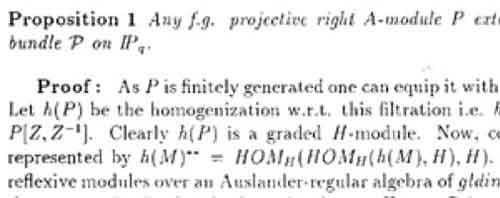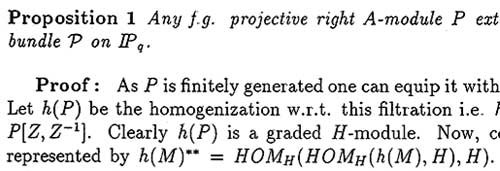Here are
my nominees for the 2006 paper of the year award in mathematics &
mathematical physics : in math.RA : math.RA/0606241
: Notes on A-infinity
algebras, A-infinity categories and non-commutative geometry. I by
Maxim Kontsevich and
Yan Soibelman. Here is the abstract :
We develop
geometric approach to A-infinity algebras and A-infinity categories
based on the notion of formal scheme in the category of graded vector
spaces. Geometric approach clarifies several questions, e.g. the notion
of homological unit or A-infinity structure on A-infinity functors. We
discuss Hochschild complexes of A-infinity algebras from geometric point
of view. The paper contains homological versions of the notions of
properness and smoothness of projective varieties as well as the
non-commutative version of Hodge-to-de Rham degeneration conjecture. We
also discuss a generalization of Deligne’s conjecture which includes
both Hochschild chains and cochains. We conclude the paper with the
description of an action of the PROP of singular chains of the
topological PROP of 2-dimensional surfaces on the Hochschild chain
complex of an A-infinity algebra with the scalar product (this action is
more or less equivalent to the structure of 2-dimensional Topological
Field Theory associated with an “abstract” Calabi-Yau
manifold).
why ? : Because this paper
probably gives the correct geometric object associated to a
non-commutative algebra (a huge coalgebra) and consequently the right
definition of a map between noncommutative affine schemes. In a previous post (and its predecessors) I’ve
tried to explain how this links up with my own interpretation and since
then I’ve thought more about this, but that will have to wait for
another time. in hep-th : hep-th/0611082 : Children’s Drawings From
Seiberg-Witten Curves by Sujay K. Ashok, Freddy Cachazo, Eleonora
Dell’Aquila. Here is the abstract :
We consider N=2
supersymmetric gauge theories perturbed by tree level superpotential
terms near isolated singular points in the Coulomb moduli space. We
identify the Seiberg-Witten curve at these points with polynomial
equations used to construct what Grothendieck called “dessins
d’enfants” or “children’s drawings” on the Riemann
sphere. From a mathematical point of view, the dessins are important
because the absolute Galois group Gal(\bar{Q}/Q) acts faithfully on
them. We argue that the relation between the dessins and Seiberg-Witten
theory is useful because gauge theory criteria used to distinguish
branches of N=1 vacua can lead to mathematical invariants that help to
distinguish dessins belonging to different Galois orbits. For instance,
we show that the confinement index defined in hep-th/0301006 is a Galois
invariant. We further make some conjectures on the relation between
Grothendieck’s programme of classifying dessins into Galois orbits and
the physics problem of classifying phases of N=1 gauge theories.
why ? : Because this paper gives the
best introduction I’ve seen to Grothendieck’s dessins d’enfants
(slightly overdoing it by giving a crash course on elementary Galois
theory in appendix A) and kept me thinking about dessins and their
Galois invariants ever since (again, I’ll come back to this later).


